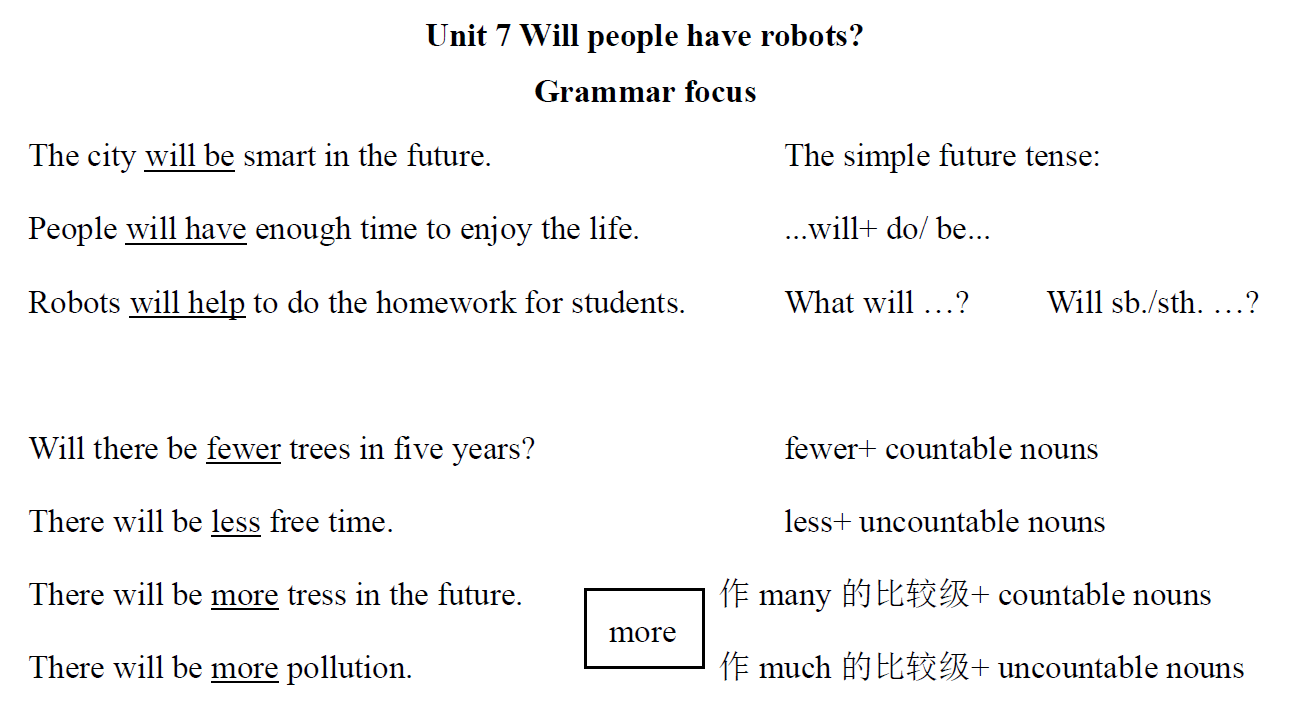Good morning, dear judges! I’m very glad to be here to present my class today. I’m No. 1 candidate applying for middle school English teacher. And my topic today is Unit 7 Will people have robots? In order to make my presentation much clearer, I’m going to divide it into 6 parts, that is, the analysis of teaching materials, analysis of students, teaching methods, learning methods, teaching procedures and blackboard design. Now I am going to present them one by one.
一、说教材
First of all, I will give a brief analysis of teaching material. My teaching material today is Grammar Focus, from the unit 7 of Book A of Grade 8, which was published by PEP. The main content is about making predictions about the future. Students can get to know the development of robots and the seriousness of environment pollution around the world. The topic is closely related to students’ daily life and can arose students’ awareness of protecting the environment.
Teaching Objectives
Given the analysis of teaching materials, the teaching objectives are designed as follows:
1. Students can understand the basic meaning of the simple future tense and learn to use the simple future tense correctly.
2. Students can tell the difference of the words: more, less, fewer to describe the quantity in the comparative degree.
3. Students can use the simple future tense to talk about the predictions in the future.
4. Students can use the comparative degree correctly.
5. Cultivate students’ positive attitude towards the changes in the future.
Teaching Key and Difficult Points
Based on the objectives, I make the teaching key points and difficult points as follows:
Using the simple future tense correctly to talk about the changes and things in the future is the teaching key point. To foster students’ positive attitude towards future life is the teaching difficult point.
二、说学情
After the analysis of teaching material, now let me analyze the students. Students in grade 8 are around the age of 15. With the increase of their age, students’ cognitive capacity has been improved significantly and their abstract thinking ability is developing quite obviously. They can control themselves much better and can be more focused on language study. They have learned the way of deducing and inducing in the process of learning grammar. They have already learned the sentence pattern “be going to”, which is closely related to “will”. But their ability of deducing and inducing still needs to be improved. They need the guidance of the teacher.
三、说教学方法
Teaching Method
According to the analysis of teaching materials and students, I am going to arrange my lesson by mainly adopting the task-based language teaching method, inducing method, and deducing method. That exactly meets the requirement of modern foreign language teaching, which emphasizes that students should be encouraged to develop effective learning strategies and autonomous learning abilities by means of experiencing, practicing, participating, exploring and cooperating under the teacher’s guidance.
Learning Method
Students will acquire the English knowledge and improve their English skills by autonomic learning, cooperating, exploring, and so on.
四、说教学过程
According to the above analysis, teaching procedures —the most important part are designed as follows:
Step 1: Lead-in
At the beginning of the class, I will show some pictures of future life in the movies, such as Pacific Rim, Artificial Intelligence and The Day After Tomorrow, then I will ask students to talk about the future life. I will ask some questions like “What are these pictures on the screen about? What do you know about the future life?” I will lead students to answer with “will” sentences and write the sentences on the blackboard.
The purpose of this step is to elicit the topic of predicting future life and to arouse students’ learning interests. Meanwhile, I can prepare the sentences that will be used in the next step.
Step 2: Presentation
As for presentation part, I will use the sentences on the blackboard and ask students to induce what the sentences have in common, thus to get the usage and sentence structure of simple future tense. Then, I will ask students to work in groups to work out the affirmative form, the negative form and the general question form of the simple future tense.
This step is designed to present today’s new sentence structure: the simple future tense. Inducing method is used here to promote students’ thinking ability. They can induce according to the sentences they have learned before, which can help them have a comprehensive understanding of English learning.
Then, I will show students another four sentences which include the words fewer, less and more. I will ask students to discuss in groups again and summarize the usage of these words. Before this lesson, students have already learned comparative degree in unit 3. So they have got some knowledge in comparative degree. It is not very hard for them to figure out the usage of fewer, less and more in groups. Meanwhile, they can have a better understanding of how to cooperate with others.
Step 3: Practice
To practice what they have learned in this lesson, I have 2 activities. Activity one is to ask students to fill in the blanks with more, less or fewer. I will show students the sentences on the screen and lead them to apply what they’ve just learned. Activity two is to ask students to make predictions according to the pictures on the screen with “will” sentence structure. The pictures are dynamic pictures which are easy for students to predict.
In this way, the new grammar will be practiced through the deducing method and students can apply flexibly what they have learned in this lesson.
Step 4: Consolidation
To consolidate, I will first divide students into groups and ask them to work in groups to draw a picture of what an ideal city in the future will be like. Then I will guide them to talk about their pictures. Some of them will be invited to the front of the class to share their drawings and make an introduction. During this process, the other students and I will choose the most imaginative picture.
The task-based language teaching method adopted in this step to improve students’ communication skills and cultivate their imagination.
Step 5: Summary
Students will be asked to summarize what they have learned in this class. Then I will make some supplements and ask students to keep a positive attitude towards the changes in the future.
Thus, students can summarize what the learned and the teacher can check the effect of the class and make plans for the next class.
Step 6: Homework
For the final part of this lesson, I will ask students to share with their family members about the ideal city in the future and collect their family members’ ideas. They can share these opinions in the next class.
By doing the homework, students can strengthen what they have learned after class. And they can use the key sentences and words in their real life.
五、说板书设计
After finishing the part of teaching procedure, I will come to the last part: design of the blackboard. As you can see, I will write several sentences on the blackboard to help students induce and summarize the grammar focus.
By looking at the blackboard, it is helpful and clear for students to get the main content of this lesson quickly.












